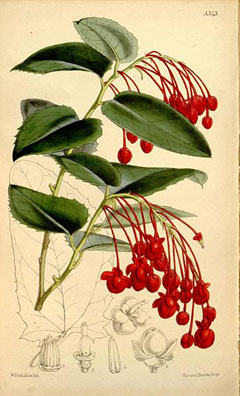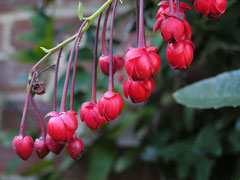 |
|
http://commons.wikimedia.org/wiki/File:Berberidopsis_corallina.jpg |
 |
| http://www.flickr.com/people/28438417@N08 |
Translate this page:
Summary
Physical Characteristics

 Berberidopsis corallina is an evergreen Climber growing to 5 m (16ft 5in) at a medium rate.
Berberidopsis corallina is an evergreen Climber growing to 5 m (16ft 5in) at a medium rate.
See above for USDA hardiness. It is hardy to UK zone 8 and is frost tender. It is in leaf all year, in flower from July to September. The species is hermaphrodite (has both male and female organs).
Suitable for: light (sandy), medium (loamy) and heavy (clay) soils. Suitable pH: mildly acid and neutral soils. It can grow in full shade (deep woodland) or semi-shade (light woodland). It prefers moist soil.
UK Hardiness Map
US Hardiness Map
Synonyms
Plant Habitats
Woodland Garden Dappled Shade; Shady Edge; not Deep Shade; North Wall. By.
Edible Uses
References More on Edible Uses
Medicinal Uses
Plants For A Future can not take any responsibility for any adverse effects from the use of plants. Always seek advice from a professional before using a plant medicinally.
None known
References More on Medicinal Uses
The Bookshop: Edible Plant Books
Our Latest books on Perennial Plants For Food Forests and Permaculture Gardens in paperback or digital formats.

Edible Tropical Plants
Food Forest Plants for Hotter Conditions: 250+ Plants For Tropical Food Forests & Permaculture Gardens.
More

Edible Temperate Plants
Plants for Your Food Forest: 500 Plants for Temperate Food Forests & Permaculture Gardens.
More

More Books
PFAF have eight books available in paperback and digital formats. Browse the shop for more information.
Shop Now
Other Uses
Basketry
The stems are quite flexible and are used in basket-making[247].
Special Uses
References More on Other Uses
Cultivation details
Prefers a deep, moist, humus-rich soil and a position where it is sheltered from drying winds and strong sunlight[11, 200]. This species will tolerate a slightly alkaline soil if peat or some other acid medium is added, but it is not really suited to chalky soils[11]. This species is not very hardy outdoors in Britain[11], tolerating temperatures down to about -10°c so long as this is not for prolonged periods[200]. It succeeds in the more westerly areas of the country, but in general needs the protection of a wall and will succeed on a south-facing wall so long as it is protected from winds from that quarter[11]. If the top-growth is cut back by winter cold, the plant can re-sprout from the rootstock[200]. A climbing plant, growing up through trees and shrubs and supporting itself by twining around them[200]. The plant usually forms fruit in Britain, but the seed is seldom fertile[11].
References Carbon Farming Information and Carbon Sequestration Information
Temperature Converter
Type a value in the Celsius field to convert the value to Fahrenheit:
Fahrenheit:
The PFAF Bookshop
Plants For A Future have a number of books available in paperback and digital form. Book titles include Edible Plants, Edible Perennials, Edible Trees,Edible Shrubs, Woodland Gardening, and Temperate Food Forest Plants. Our new book is Food Forest Plants For Hotter Conditions (Tropical and Sub-Tropical).
Shop Now
Plant Propagation
Seed - best sown in a warm greenhouse in early spring. The seed can take 12 months or more to germinate and there is usually a poor germination rate[247]. When the seedlings are large enough to handle, prick them out into individual pots. Grow them on a shady part of the greenhouse for at least their first winter and then plant them out in late spring or early summer, after the last expected frost. Consider giving the plant some protection from the cold for their first winter or two outdoors. Cuttings of half-ripe wood, July/August in a frame[200]. Layering.
Other Names
If available other names are mentioned here
Native Range
SOUTHERN AMERICA: Chile
Weed Potential
Right plant wrong place. We are currently updating this section.
Please note that a plant may be invasive in one area but may not in your area so it's worth checking.
Conservation Status
IUCN Red List of Threatened Plants Status :

Growth: S = slow M = medium F = fast. Soil: L = light (sandy) M = medium H = heavy (clay). pH: A = acid N = neutral B = basic (alkaline). Shade: F = full shade S = semi-shade N = no shade. Moisture: D = dry M = Moist We = wet Wa = water.
Now available:
Food Forest Plants for Mediterranean Conditions
350+ Perennial Plants For Mediterranean and Drier Food Forests and Permaculture Gardens.
[Paperback and eBook]
This is the third in Plants For A Future's series of plant guides for food forests tailored to
specific climate zones. Following volumes on temperate and tropical ecosystems, this book focuses
on species suited to Mediterranean conditions—regions with hot, dry summers and cool, wet winters,
often facing the added challenge of climate change.
Read More
Expert comment
Author
Hook.f.
Botanical References
11200
Links / References
For a list of references used on this page please go here
Readers comment
| Add a comment |
|
If you have important information about this plant that may help other users please add a comment or link below. Only comments or links that are felt to be directly relevant to a plant will be included. If you think a comment/link or information contained on this page is inaccurate or misleading we would welcome your feedback at [email protected]. If you have questions about a plant please use the Forum on this website as we do not have the resources to answer questions ourselves.
* Please note: the comments by website users are not necessarily those held by PFAF and may give misleading or inaccurate information.
To leave a comment please Register or login here All comments need to be approved so will not appear immediately.
|
Subject : Berberidopsis corallina
|
|
|
|